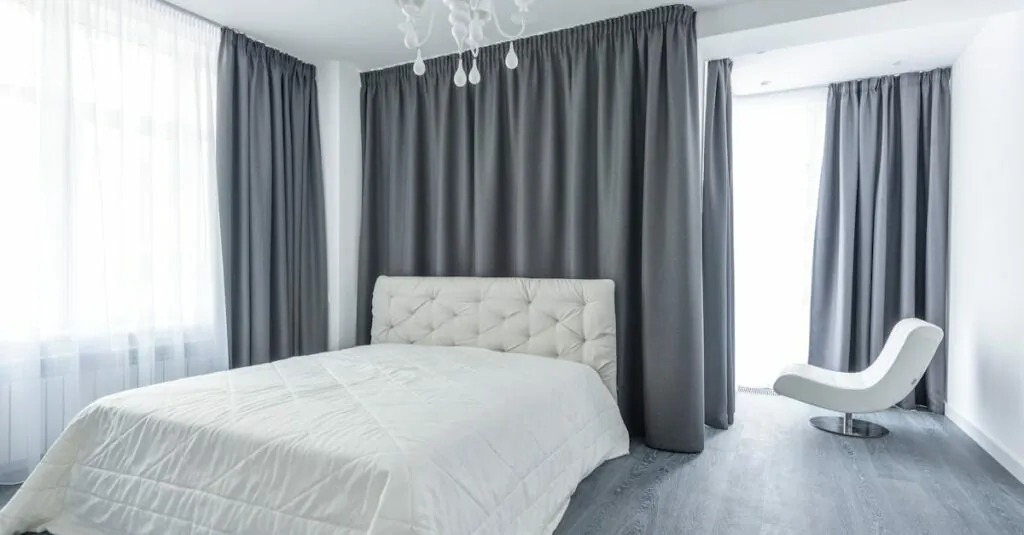In a world where sleep often takes a backseat to our busy lives, designing a sleep sanctuary can feel like a secret superpower. Imagine transforming your bedroom into a cozy haven where stress fades away and sweet dreams take over. It’s not just about aesthetics; it’s about creating a space that cradles you in comfort and whispers, “You’re home.”
From plush bedding that feels like a cloud to lighting that sets the mood, every detail counts. Who knew that a well-placed pillow could be the difference between counting sheep and counting Z’s? Dive into the art of sleep sanctuary design and discover how a few thoughtful tweaks can turn your nightly routine into a luxurious escape. After all, a well-rested mind is a happy mind, and who doesn’t want to wake up feeling like a rockstar?
Table of Contents
ToggleUnderstanding Sleep Sanctuary Design
Creating a sleep sanctuary plays a vital role in enhancing overall well-being. Designing a space dedicated to relaxation can significantly improve sleep quality.
Importance of Sleep Sanctuary Design
A well-designed sleep sanctuary promotes restful sleep and reduces stress. Prioritizing comfort and aesthetics leads to a welcoming atmosphere. Studies show that environments conducive to relaxation can help lower anxiety levels. In addition, a calming space aids in establishing a nighttime routine. Implementing thoughtful design choices encourages a less chaotic mind. Ultimately, a serene sanctuary supports restorative sleep and enhances daily productivity.
Key Elements of a Sleep Sanctuary
Focus on several key elements to cultivate an effective sleep sanctuary. First, select high-quality bedding and mattresses that promote comfort. Soft textures encourage a restful environment. Second, consider the room’s lighting; adjustable options, like dimmable lamps, can create the right ambiance. Third, incorporate calming colors; hues such as blues, greens, or neutral tones evoke tranquility. Next, ensure proper ventilation; fresh air circulation fosters relaxation. Lastly, minimize clutter to create a peaceful and organized space. Prioritizing these elements can transform any bedroom into a restful retreat.
Creating a Sleep-Friendly Environment
Designing a sleep-friendly environment involves careful consideration of various elements that can enhance comfort and relaxation.
Color Schemes and Decor
Select calming colors that promote tranquility. Soft blues, greens, and neutrals create a serene atmosphere. These shades lower anxiety levels and encourage restful sleep. Incorporate decor elements that reflect personal style while prioritizing comfort. Artwork with soothing imagery or textures can enhance the space’s overall ambiance. Additionally, use fabrics like cotton and linen to create a cozy feel. These materials are breathable and contribute to a peaceful environment. Choosing decor that aligns with a calming color palette fosters a welcoming retreat for restorative sleep.
Furniture Selection and Arrangement
Choose furniture pieces that serve a functional purpose, enhancing comfort and style. Opt for a supportive mattress and pillows that cater to individual sleep preferences. Nightstands should provide easy access to essentials without cluttering the space. Arrange furnishings to promote flow and openness, allowing for easy movement around the room. Consider placing the bed in a position that benefits from natural light while maintaining privacy. A well-structured layout not only maximizes space but also creates a harmonious atmosphere conducive to relaxation. Prioritize multifunctional furniture that supports organization and enhances the sleep sanctuary experience.
Incorporating Natural Elements
Incorporating natural elements into a sleep sanctuary enhances comfort and tranquility. Prioritizing plants and natural light creates a refreshing atmosphere.
Use of Plants and Natural Light
Plants improve air quality and add a vibrant touch to the bedroom. Choosing low-maintenance species, like snake plants and peace lilies, provides greenery without added stress. Natural light contributes significantly to mood regulation and circadian rhythms. Positioning the bed near windows maximizes sunlight exposure during the day. Keeping blinds open allows for gentle illumination, promoting a sense of calm.
Benefits of Nature in Sleep Spaces
Nature encourages relaxation and reduces stress levels in sleep spaces. Indoor greenery contributes to improved mental well-being and fosters a serene environment. Studies reveal that exposure to nature positively impacts sleep quality and duration. Surrounding oneself with natural elements creates a peaceful retreat and enhances overall health. Prioritizing earthy tones and textures in decor complements the calming effect of greenery, bridging comfort and style.
Technology and Sleep Sanctuary Design
Technology plays a crucial role in enhancing sleep sanctuary design. Implementing smart home features can significantly improve sleep quality.
Smart Home Features
Smart lighting systems, such as Philips Hue, allow users to adjust brightness and color temperature. Users can create pre-set lighting schedules that promote relaxation before bedtime. Smart thermostats, like Nest, ensure optimal temperature throughout the night. Integration with white noise machines can mask disruptive sounds, providing a tranquil environment. Sleep tracking devices, including Fitbit or Oura Ring, offer insights into sleep patterns. These metrics empower individuals to make better lifestyle choices for improved rest.
Balancing Technology and Relaxation
Balancing technology with relaxation is essential in a sleep sanctuary. Excessive screen time before bed can hinder melatonin production. Establishing device-free hours provides a calming atmosphere conducive to restful sleep. Incorporating features like blue light filters on devices can reduce potential disruptions. Soft, programmable lighting can adjust gradually, mimicking sunrise and aiding natural wakefulness. Managing distractions from notifications by enabling do-not-disturb modes fosters a peaceful environment. Ultimately, prioritizing relaxation while utilizing technology can enhance sleep experiences.
Creating a sleep sanctuary is essential for enhancing both sleep quality and overall well-being. By focusing on comfort and tranquility through thoughtful design choices, individuals can transform their bedrooms into peaceful retreats. Incorporating elements like calming colors, high-quality bedding, and natural features fosters an inviting atmosphere that promotes relaxation.
Balancing technology with a serene environment ensures that sleep remains a priority. Embracing these design principles not only leads to better rest but also supports a healthier lifestyle. As individuals invest in their sleep spaces, they pave the way for improved daily productivity and a more fulfilling life.




